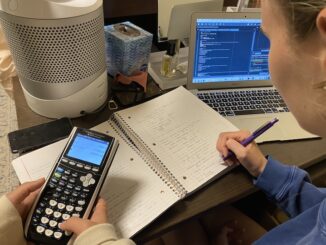
Students all know the email. It appears in their inbox right before each semester with a subject line in all caps that reads “PAYMENT REMINDER.”
But what exactly are they paying for?
Pepperdine’s tuition is and has always been notoriously pricey. To study for one year as an undergraduate student, without financial aid, a student must pay $51,740, according to the Pepperdine Seaver College 2017-18 Financial Aid Brochure. This number doesn’t include room and board nor the student activity fee. It covers 12-18 units of class and is the same for both in and out-of-state students.
“College is such an investment,” sophomore theater major Buddy Kennedy said. “You need to know, or at least you should care about knowing, what you’re paying for and where your money is going.”
Students often see this sticker price of $50,000 as a bit excessive but they pay the price without question. The majority don’t know what the money they pay is actually used for. A Pepp Post poll of 53 students from all grade levels found that everyone seems to have a different perception about Pepperdine’s spending.
Where do students think their tuition money goes?
The poll found that around 60 percent of students believe that the majority of their tuition goes toward the funding of new construction projects on campus, such as the Seaside Residence Hall, or toward administration salaries.
Interestingly enough, “construction projects do not fall under Seaver,” said Nicole Marrs, director of Budget and Analytics for Seaver College. “We do a lot of fundraising for construction projects.”
Students were both surprised and thrilled to hear that. Many had no idea that construction fell under an entity outside of Seaver College.
“They’re always building something and I’m always just like, ‘Ugh, how much do we need?’” Kennedy said. “But hey! If it’s not out of my pocket, this is a great library so keep it coming.”
Andie Smith, a senior psychology pre-med major, agreed.
“I had no idea … I think that’s really respectable that they would do that,” Smith said. “I’m amazed that they were able to raise that much money from their donors and from alumni.”
Students appreciate these donor gifts and fundraising efforts more than people might think. There’s an overwhelming perception at Pepperdine that no one struggles with ‘paying the bills’ and that everyone is generally well-off.
However, this perception is largely inaccurate. The Pepp Post poll found that roughly 85 percent of Pepperdine students are attending on some sort of scholarship and a little more than 60 percent wish that the university would seek more ways to lower tuition rates.
“Pepperdine kind of has this stereotype where everyone’s wealthy … and that because we go to school in Malibu, that we are just at some higher social class than everyone else,” Giuli Colon-Roisenzvit, a sophomore psychology pre-law major, said. “But realistically, everyone I’ve met is kind of normal and no one has a crazy amount of money.”
Without construction as a part of the Seaver budget, many students turned to Pepperdine’s location as a possible major factor in the tuition cost.
“I don’t know if the high tuition accounts for the location that we’re in,” Joseph Baena, a junior business administration major, said.
Seaver College Dean Michael Feltner was quick to dispel this general perception.
“We own it,” Feltner said. “The land was gifted to the institution when the campus was moved to Malibu in the 70s.”
Where does the money actually go?
“The vast, vast majority of every dollar that comes into Pepperdine University is spent on things directly related to instruction or things that support instruction or support the educational experience,” Feltner said. “Very little goes to all those things that I think people naturally tend to want to be concerned about.”
In fact, if each dollar Seaver College received from tuition were broken down into two parts, “about 27 cents of it goes to fund student aid and then the other 73 cents goes to fund the delivery of the educational curricular and co-curricular programs,” Marrs said.

the other 27 cents helps fund student aid (Canva.com graphic created by Julia Stratton).
However, some students believe that dividing every tuition dollar into only two sections, while informative, is a little too vague.
“That’s just a broad statement and I’d want to know more,” Smith said.
Many students, including Kennedy and Amanda Cooper, a first-year media production major, didn’t understand when Marrs said “curricular and co-curricular programs,” she was actually referencing the university’s academic programs, technology upgrades, faculty salaries and student organizations. Anything that enhances students’ learning falls under the category of “curricular and co-curricular” spending.
Feltner explains this broad portion of the budget every year in the annual State of the College Dean’s Address.
“I do a public address every October and that address is put on the web,” Feltner said. “It has a breakdown on percent basis by division and how much goes to academics.”
Statistics courtesy of Pepperdine’s State of the College Dean’s Address 2017.
Statistics courtesy of Pepperdine’s State of the College Dean’s Address 2017.
“Within Seaver College,” Feltner said, “every penny that we get is related to something that either is getting the students to Seaver College, delivering the educational experience that we offer at Seaver College and then a tiny amount goes toward engaging with alumni afterward.”
Often times, things such as graduation, summer sessions or emergency funds aren’t considered when students think about tuition. The Give2Pepp initiative offered a Convocation where Colon-Roisenzvit learned details about Pepperdine’s emergency fund and was excited to see that administration was prepared to help students in personal crisis situations.
“No one thinks about that stuff and they’re not things that you can really plan for either,” Colon-Roisenzvit said. “I thought it was really great that Pepperdine does that.”
But most importantly, Seaver College, being a non-profit entity, uses the majority of their budget to pay people.
“Education is a people-intensive business,” Feltner said. “People are expensive and we want good people here and you have to pay to have good people.”
Some students agreed with Feltner and were able to quickly pinpoint the faculty as the university’s biggest investment.
“I feel like most of the tuition money goes to paying the professors,” Baena said.
Tuition is higher at Pepperdine to keep class sizes down, and Seaver minimizes how many large lecture classes students take. Feltner said that if Seaver were to divide all current 200-person Elkins Auditorium classes into 15-person, discussion-based classes, that would require the addition of about 15-20 faculty members.
With Pepperdine’s low student-to-faculty ratio of 13:1, an addition like that would cost “several million dollars,” Feltner said.
“I often forget how well-looked-upon our education is here at Pepperdine,” Smith said. “Now that I’m a senior and I’m about to graduate … I’m realizing how heavy the title is of Pepperdine.”
Where do students believe their tuition money should go?
Roughly 60 percent of students want their tuition money to go toward campus renovations and upgrades.
“We need a new gym,” Baena said with a laugh after his morning workout.
However, there are other priorities on the top of Pepperdine’s to-do list.
“It’s great that we live in an aspirational community where everyone is contributing to a conversation about how we get better,” Feltner said. “But at some point we have to make decisions and generally the things that get funded offer the greatest benefit to the most.”
The administration is listening attentively to students in making those decisions, Feltner said.
“We put $800,000 into upgrading classrooms — Seaver College classrooms — last year,” Feltner said. “The university is considering a student recreation and events center right now that will add dining and recreational facilities and create a hub for students.”
Austin Welch, SGA president and junior business administration major, fields a lot of these requests from students. He reminds them that the Pepperdine administration constantly has to think about the future.
“Yes, the university has obligations to all of us,” Welch said, “but they also have obligations to students 5, 10, 15 years in advance.”
In the meantime, Pepperdine’s main focus will continue to remain on the faculty and professors.
“We have the best teachers ever,” Kennedy said. “They just love the students and I think they should get a little bit more than what they’re getting. I don’t even know what they are getting, but it probably isn’t enough because they deserve the world.”
The Seaver College Dean’s Office feels confident with their financial decisions for the upcoming year, including the tuition increase administrators announced March 15.
“Every decision that I make that involves an expenditure, I view it through the eyes of students,” Feltner said. “I think we deliver on what we’re asked to deliver on and I think there is value in that.”
Julia Stratton completed the reporting for this story under the supervision of Dr. Christina Littlefield and Dr. Theresa de los Santos in Jour 241 in spring 2018. Dr. Littlefield supervised the web story.




